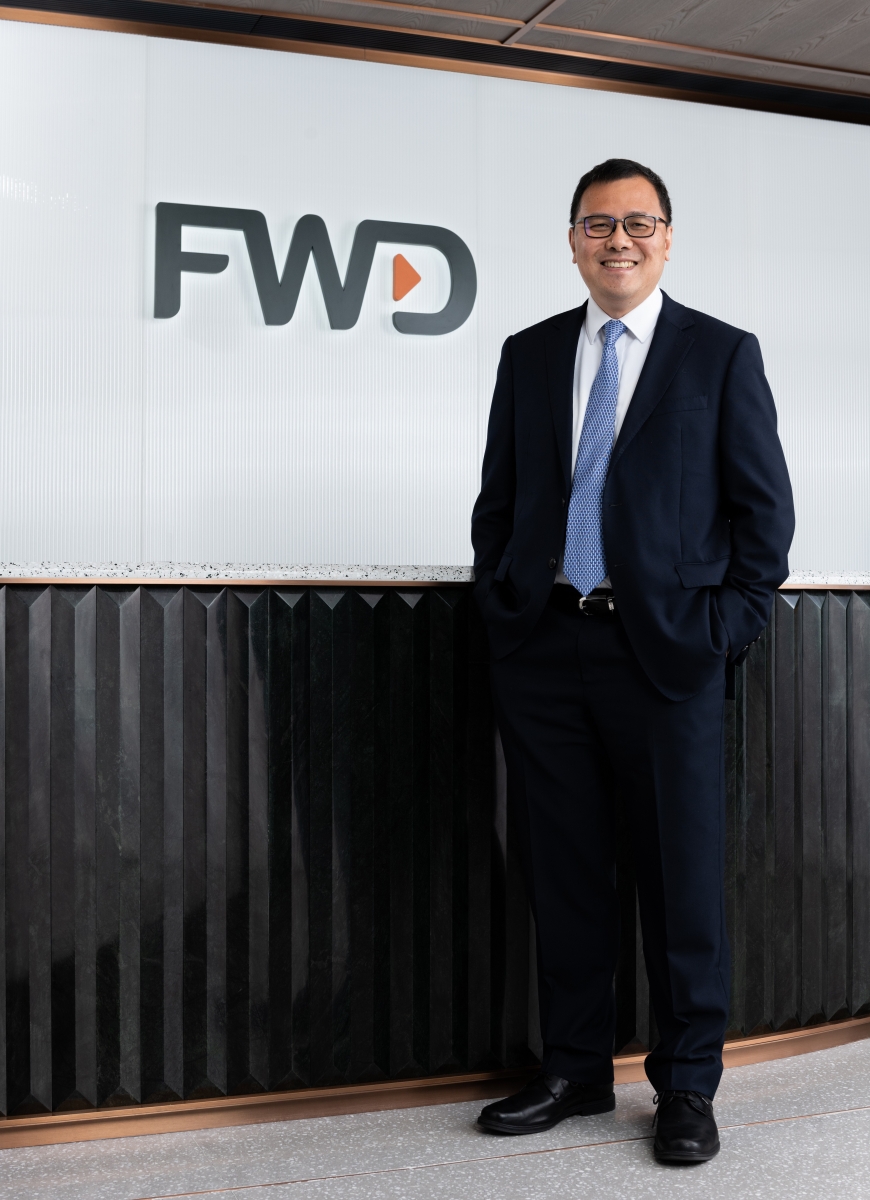
Hong Kong’s top 50 insurers experience 7.7% YoY premium contraction in 2022
Analysts said the market’s complex financial environment and shrinking population curtailed industry growth. Cross-border expansion could alleviate contraction pains.
The premiums of Hong Kong’s top 50 insurers contracted by 7.7% year-on-year (YoY) in 2022, on the back of lower demand for linked products, decreased population size, and market uncertainty, the Hong Kong Business Insurance Rankings revealed. In total, the top 50 companies saw their premiums reach HK$511.7b, smaller than the HK$554.2b in 2021.
“In 2022, the linked products business decreased by over 50%, in terms of premiums industry-wide. This reflects this lower demand because the financial markets didn’t do well. And so people don’t want to buy insurance-linked products Assistant Professor Ben Charoenwong, from the Department of Finance at NUS Business, told Hong Kong Business.

Ben Charoenwong, Assistant Professor at the Department of Finance at NUS Business
The drop in overall premiums is linked to complexities in financial markets. Both stocks and bonds faced significant losses simultaneously, leading potential policyholders to adopt a cautious stance.
“Of course, the funny thing for me — someone who studies the financial markets — is typically after you have a bad year, it tends to be better afterwards. And so you might want to start products when the price falls rather than avoid them,” Charoenwong said.
He said he anticipates a potential rebound in demand as market sentiment stabilises. Nevertheless, persistent demographic factors, including business closures and population shifts out of Hong Kong, may present a lasting obstacle to a complete recovery.
To tally, 26 life or “long-term” insurers were included in this year’s rankings whilst 24 general insurers were counted. The life segment, which accounts for 91.3% of the rankings’ grand total, fell 8.9% YoY. On the other hand, Hong Kong’s top general insurers, 8.7% of the total, expanded by 7.1%.
Out of the top 15 insurers in Hong Kong, only five saw their premiums grow YoY. Namely, HSBC Life (third place, 33.3%), Hang Seng Insurance ( eighth, 36.8%), FTLife (11th, 27.6%), AXA General (14th, 4.0%), and Chubb Life (15th, 1.8%).
In terms of premiums accumulated, at first place is AIA International, which saw its 2022 premiums dip 14.8%. Trailing behind is Prudential Life at 2nd place, which also contracted by 12.0%. Insurers that followed were Manulife (4th, -22.8%), China Life (5th, -24.5%), AXA China (Bermuda at 6th place, -5.6%), BOC Life (7th, -10.6%), FWD Life (Bermuda at 9th, -23.8%), TPLHK (10th, -7.8%), Sun Life (12th, 23.6%), and YF LIFE (13th, 2.5%).
Examining the long-term trends, Charoenwong highlighted the impact of the ageing population in Asia on the insurance industry. As the workforce shrinks and older individuals seek coverage, a potential decline in premiums is expected over time.
Hong Kong, being a mature financial market, may already have a significant portion of its population covered. This demographic shift places a burden on insurers, necessitating strategic expansion beyond borders to mitigate the impact of an ageing population.
“Hong Kong is already a decently developed financial market. Many people may already have insurance, right? So then the only effect they might see is this kind of mega trend of decreasing premiums over time, just because there are just fewer people. We kind of saw this in Japan. And that's part of why Japanese insurers worked hard to expand across borders, to try to go to Vietnam, the Philippines and so on. Because their population is ageing,” Charoenwong stated.
What insurers are doing to catch up
To stay competitive, traditional insurers must improve their digital infrastructure, invest in user-friendly apps and websites, and streamline their claims processes. Whilst the transition may present challenges for incumbents, Charoenwong views these changes as beneficial for consumers, ensuring a more efficient and seamless insurance experience.
Similarly, Hong Kong Insurance Leader Billy Wong and partner Richard Hart of PwC Hong Kong said in a report that insurers in Hong Kong have been actively undergoing digital transformation, catching up with changing customer expectations. The rise of virtual insurers and the pandemic have accelerated the adoption of digital tools, such as chatbots and e-signatures.

Billy Wong, Hong Kong Insurance Leader and Richard Hart, partner at PwC Hong Kong
Digitalisation across the value chain is a top priority for Hong Kong insurers to enhance customer experience, streamline operations, and remain competitive. Insurers are expanding ecosystem partnerships to offer more value to customers beyond traditional transactions. The focus on the Greater Bay Area (GBA) provides opportunities for cross-border collaborations and partnerships.
Hong Kong insurers are actively incorporating Environmental, Social, and Governance (ESG) principles into their operations, underwriting standards, and product offerings. This aligns with the growing emphasis on sustainability in the region.
“With the emphasis and need for ESG growing across Hong Kong and Greater China, Hong Kong insurers are taking action to stay ahead of the game,” Wong and Hart said. “In recent years we have seen Hong Kong players actively embed ESG into their business operations, for example through changing underwriting and investment standards according to ESG principles and rolling out new products specifically to address key protection gaps and pandemic-related losses.”
On top of that, talent acquisition and upskilling are crucial for insurers in Hong Kong to meet the demands of digital transformation, ESG integration, and cross-border expansion within the GBA. Data analytics and project management skills are highly valued, said PwC.
Successful execution of large-scale transformation programmes requires agility, a people-oriented approach, strong change-management capabilities, and clear alignment on outcomes. The GBA’s evolving landscape adds complexity to cross-border operations.
From the insurer’s perspective, Patrick Graham, Chief Executive Officer of Manulife Hong Kong and Macau indicated that “recruitment and nurturing of top-notch talent” will be one of their main priorities in 2024. Other areas that they will prioritise are enhancing their productivity, and bridging the gaps in the health and protection needs of domestic customers, mainland Chinese visitors (MCV), and its high-net-worth clientele.

Patrick Graham, Chief Executive Officer of Manulife Hong Kong and Macau
“To achieve these goals, we will continue to bolster our agency support with the latest digital tools and advanced data analytics, while further expanding our medical partner networks across Hong Kong, Macau, and Mainland China to facilitate more efficient service and a simplified experience,” said Graham.
In a separate interview, Man Kit Yip, Chief Executive Officer of FTLife said further reopening of Hong Kong’s economy will further drive premiums in 2023
“Strong pent-up demand released from mainland visitors after the border reopened spurred the noticeable growth in FTLife’s overall Annual Premium Equivalent (APE). The overall APE increased by 47% year-on-year to HK$2.6b, mainland visitors accounted for about 30% of the overall APE,” Yip told Hong Kong Business.

Man Kit Yip, Chief Executive Officer of FTLife
“FTLife continued to enrich its product offerings in FY2023 to cater to customer needs and was an early mover in the market to fully integrate ESG into its investment portfolio,” he added.
In another interview with Hong Kong Business, Ken Lau, managing director of Greater China and Hong Kong Chief Executive Officer of FWD said its new business growth underscores the efficacy of the company's strategic focus on the Hong Kong market and its adept seizing of opportunities in the GBA. The success across all sales channels further validates our technology-driven, customer-centric multi-channel distribution strategy.
“We look forward to seising the opportunities during the travel season in the fourth quarter and the first quarter of next year. We aim to meet the increasing demand for protection from [mainland China visitors] and further strengthen our presence in the Hong Kong market,” Lau added.

Ken Lau, managing director of Greater China and Hong Kong Chief Executive Officer of FWD
Outlook
Looking ahead, NUS Business’ Charoenwong anticipates a trend toward streamlining the insurance signup process, emphasising the need for a more digital approach.
Despite the current challenges, he foresees a potential recovery in premium payments for Hong Kong insurers in 2023, driven by a more stable financial market and interest rate situation. However, he also notes an existential challenge for the industry.
“I think there’s an overall trend to making the signup process for insurance much more streamlined. The onboarding and the signing of documents should be streamlined to move towards more digital. So that’s kind of like the megatrend for the industry, you got the demographics working against you. But we have technology that works to try to increase efficiency,” said Charoenwong.
“Probably in Hong Kong, specifically, they look to see some recovery in their premium payments as the financial markets stabilise this year [...] But over the long run, I do think there’s a little bit of an existential crisis that the insurance industry will need to come to terms with and find some way to either increase the product offering or try to expand potentially abroad because the population of Hong Kong is not going to keep rising like it was before,” he added.
Manulife’s Graham expressed careful optimism about the industry’s volatility.
“Despite potential challenges such as a slower economic recovery and shifts in interest rates that could influence overall market sentiment, we remain cautiously optimistic about Hong Kong's economic outlook. We will continue to prioritise organic and sustainable growth by introducing innovative products and services that cater to the evolving health and protection needs of our customers in both local and MCV markets.” Graham concluded.
Hong Kong insurers are expected to see strong sales in H1 2023, driven by the return of mainland China visitors, according to S&P Global Ratings. The Hong Kong life insurance industry’s earnings will be steady in the next two years due to top-line recovery and higher interest rates. New business growth for the life sector is forecasted at 20%-25% in 2023, moderating to 10%-15% in 2024, whilst the property & casualty sector is projected to sustain over 5% growth.
The increasing ties between Hong Kong insurers and mainland China customers are fueled by geographic proximity, offering an opportunity to tap into the mainland’s under-penetrated market.
Take a look at the Hong Kong Business Insurance Rankings below:
| 2023 RANK | 2022 RANK | INSURANCE COMPANY | CLASSIFICATION | 2022 PREMIUMS (HK$) | 2021 PREMIUMS (HK$) |
| 1 | 1 | AIA International | Long-term | $88.8b | $104.2b |
| 2 | 2 | Prudential (HK) Life | Long-term | $68.4b | $77.8b |
| 3 | 5 | HSBC Life | Long-term | $58.6b | $44.0b |
| 4 | 3 | Manulife (Int'l) | Long-term | $46.8b | $60.6b |
| 5 | 4 | China Life | Long-term | $35.7b | $47.3b |
| 6 | 6 | AXA China (Bermuda) | Long-term | $27.2b | $28.9b |
| 7 | 8 | BOC LIFE | Long-term | $23.8b | $26.7b |
| 8 | 10 | Hang Seng Insurance | Long-term | $22.9b | $16.8b |
| 9 | 7 | FWD Life (Bermuda) | Long-term | $21.8b | $28.6b |
| 10 | 9 | TPLHK | Long-term | $16.0b | $17.4b |
| 11 | 12 | FTLife | Long-term | $14.2b | $11.2b |
| 12 | 11 | Sun Life Hong Kong | Long-term | $9.9b | $12.9b |
| 13 | 13 | YF LIFE | Long-term | $8.9b | $9.1b |
| 14 | 16 | AXA General | General business | $4.4b | $4.3b |
| 15 | 15 | Chubb Life | Long-term | $4.3b | $4.3b |
| 16 | 17 | Bupa | General business | $4.0b | $4.1b |
| 17 | 23 | Fubon Life Hong Kong | Long-term | $3.4b | $2.3b |
| 18 | 18 | AXA China (HK) | Long-term | $3.3b | $3.7b |
| 19 | 21 | CTPI(HK) | General business | $2.7b | $2.6b |
| 20 | 22 | Zurich Insurance | General business | $2.6b | $2.4b |
| 21 | 19 | HKMCI | General business | $2.6b | $3.0b |
| 22 | 20 | HKMC Annuity | Long-term | $2.5b | $3.0b |
| 23 | 14 | AIA Everest | Long-term | $2.3b | $4.4b |
| 24 | 24 | AIG Insurance HK | General business | $2.1b | $1.9b |
| 25 | 25 | Asia Insurance | General business | $2.1b | $1.9b |
| 26 | 29 | Generali | General business | $1.9b | $1.7b |
| 27 | 30 | AIA International | General business | $1.9b | $1.7b |
| 28 | 31 | BOC Group Insurance | General business | $1.9b | $1.6b |
| 29 | 28 | XL Insurance | General business | $1.8b | $1.8b |
| 30 | 32 | Chubb Insurance | General business | $1.8b | $1.6b |
| 31 | 38 | CIGNA Worldwide General | General business | $1.6b | $1.2b |
| 32 | 39 | AGCS SE | General business | $1.5b | $1.2b |
| 33 | 33 | TPRe | General business | $1.4b | $1.5b |
| 34 | 37 | Liberty Int'l | General business | $1.4b | $1.3b |
| 35 | 27 | FWD Life (HK) | Long-term | $1.3b | $1.8b |
| 36 | 34 | Zurich International | Long-term | $1.2b | $1.4b |
| 37 | 47 | CMBWL | General business | $1.2b | $0.9b |
| 38 | 26 | Hong Kong Life | Long-term | $1.2b | $1.8b |
| 39 | 41 | Blue Cross | General business | $1.2b | $1.1b |
| 40 | 40 | QBE HKSI | General business | $1.1b | $1.1b |
| 41 | 48 | PICC (HK) | General business | $1.1b | $0.8b |
| 42 | 36 | TLIC | Long-term | $1.1b | $1.3b |
| 43 | 43 | AXA China (HK) | General business | $1.0b | $1.0b |
| 44 | 42 | AIA (HK) | Long-term | $979.9m | $1.0b |
| 45 | 45 | MSIG Insurance | General business | $978.5m | $961.1m |
| 46 | 46 | Prudential (HK) General | General business | $975.2m | $954.5m |
| 47 | 49 | CNOOC Insurance | General business | $966.6m | $638.1m |
| 48 | 44 | Principal | Long-term | $878.9m | $998.8m |
| 49 | 35 | Blue | Long-term | $815.8m | $1.3b |
| 50 | -- | Chubb Life HK | Long-term | $807.1m | -- |
| TOTAL | $511.7b | $554.2b |



















 Advertise
Advertise







